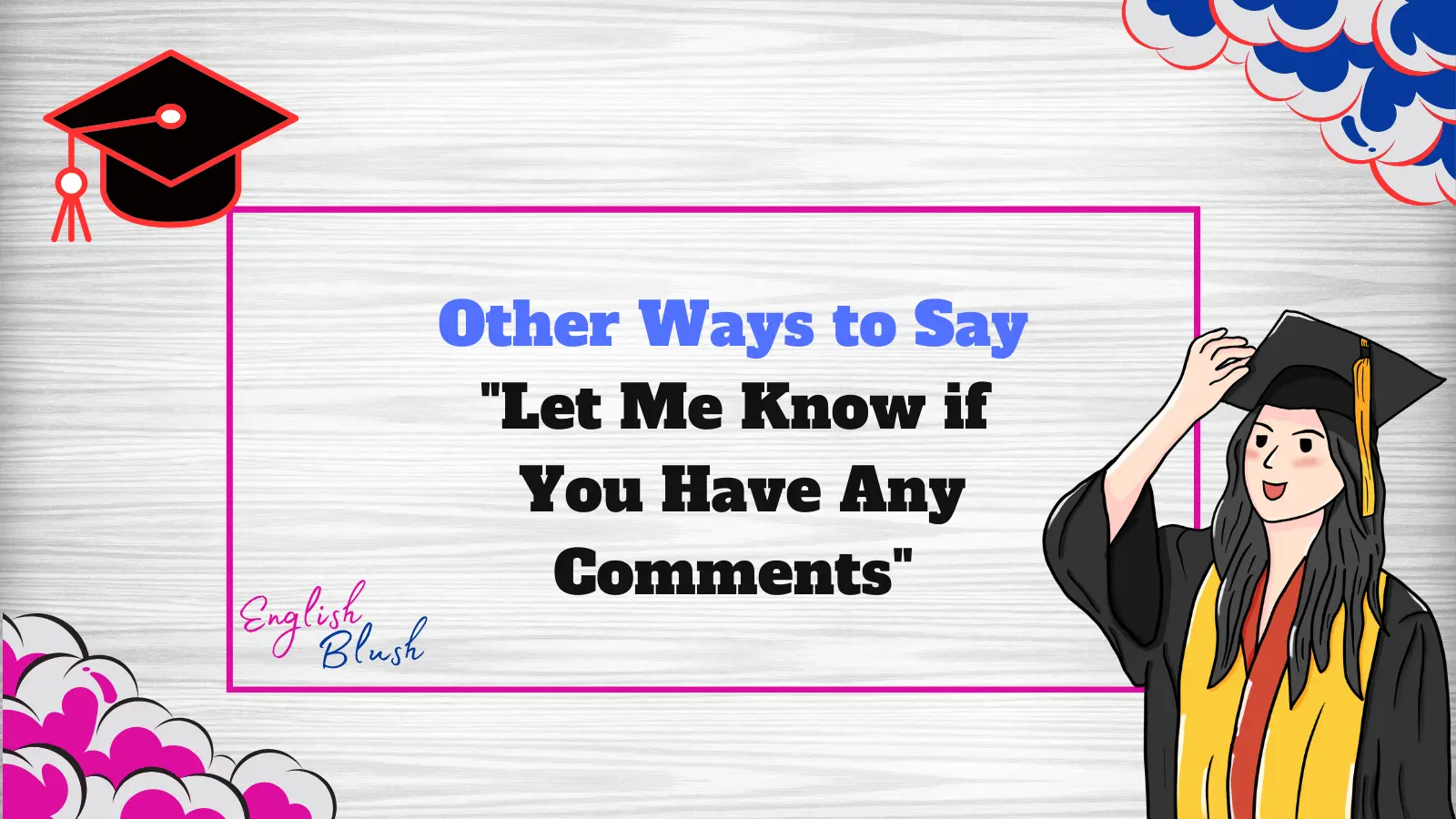Are you tired of using the same phrase, “Let me know if you have any comments”? If so, you’re not alone! It’s easy to fall into the habit of repeating certain expressions, especially in professional communication. But using the same phrases over and over can feel stale and less engaging. In this article, we’ll explore creative and effective alternatives to “Let me know if you have any comments.”
Whether you’re crafting an email, a report, or a presentation, refreshing your vocabulary will not only make your communication sound more polished but also encourage a positive response from your audience. Keep reading for some fresh ideas that will make your messages stand out!
Top List Of Other Ways to Say “Let Me Know if You Have Any Comments”
- Feel Free to Share Your Thoughts
- I’d Appreciate Any Feedback You Have
- Please Share Any Insights You May Have
- Let Me Know If You Have Any Suggestions
- I’m Eager to Hear Your Thoughts
- Please Don’t Hesitate to Share Your Feedback
- I Welcome Your Comments and Suggestions
- Let Me Know What You Think
- I’d Love to Hear Any Input You Have
- Feel Free to Provide Any Suggestions
- Please Let Me Know if Anything Needs Changing
- I Look Forward to Your Feedback
- I Would Appreciate Your Input
- Let Me Know If There’s Anything You’d Like to Add
- Please Feel Free to Share Any Concerns
- Would Love to Hear Any Thoughts You Might Have
- Let Me Know If You Have Any Suggestions for Improvement
- I’d Be Grateful for Your Feedback
- Please Let Me Know If You Have Any Observations
- I’d Be Happy to Hear Your Thoughts
- Looking Forward to Your Feedback
- Please Let Me Know If You Think Anything Needs Changing
1. Feel Free to Share Your Thoughts
This phrase is an open invitation for feedback and invites the recipient to voice any concerns or opinions they may have. It’s polite and approachable.
Scenario Example:
Email to Leo:
Subject: Request for Your Feedback on the New Marketing Strategy
Hi Leo,
I hope you’re doing well! I’ve attached the updated marketing strategy for the upcoming quarter. Feel free to share your thoughts when you have a moment. I’d love to hear any suggestions or areas where we could improve.
Best regards, Henry
Expert Addition: Using the phrase “feel free” can help soften the request, making it feel less like an obligation and more like an opportunity for collaboration.
2. I’d Appreciate Any Feedback You Have
This option is a polite way to convey that you value the recipient’s opinion. It demonstrates your willingness to listen and improve.
Scenario Example:
Email to Leo:
Subject: Request for Your Input on the Proposal
Hi Leo,
I’ve finalized the proposal and would appreciate any feedback you have. Please take a look when you have some time and let me know your thoughts.
Best regards, Henry
Expert Addition: Using “I’d appreciate” conveys a sense of gratitude, making the request sound more respectful.
3. Please Don’t Hesitate to Offer Your Comments
This phrase is a bit more formal and can be used in professional settings where you want to encourage feedback but maintain a level of formality.
Scenario Example:
Email to Leo:
Subject: Draft for Your Review
Hi Leo,
I’ve attached the first draft of the report. Please don’t hesitate to offer your comments or any suggestions you think might improve it.
Looking forward to hearing your thoughts, Henry
Expert Addition: “Don’t hesitate” is often used in customer service and formal settings because it creates an inviting tone while still sounding professional.
4. Let Me Know What You Think
A direct and straightforward approach, this phrasing invites the recipient to offer their thoughts quickly and without formality.
Scenario Example:
Email to Leo:
Subject: Feedback on the Design Mockups
Hi Leo,
I’ve attached the design mockups for the new website. Let me know what you think and if there’s anything you’d like me to adjust.
Thanks, Henry
Expert Addition: This phrase works well in casual or internal communications where you’re comfortable with a less formal tone.
5. I’d Love to Hear Your Thoughts
This expression conveys enthusiasm and eagerness to hear the recipient’s feedback, making it great for creative discussions.
Scenario Example:
Email to Leo:
Subject: Thoughts on the New Branding Concept
Hi Leo,
I’ve attached the new branding concept we’re considering. I’d love to hear your thoughts on it when you have a chance.
Best, Henry
Expert Addition: Adding “I’d love” makes the request sound more enthusiastic, which can be a great motivator for the recipient to respond more positively.
6. Please Share Your Insights
“Insights” adds a level of sophistication to your request and works well when you need thoughtful or detailed feedback.
Scenario Example:
Email to Leo:
Subject: Request for Your Insights on the Report
Hi Leo,
I’ve completed the report for our upcoming presentation. Please share your insights when you have a moment, especially if there are any areas I could improve.
Thanks, Henry
Expert Addition: The use of “insights” suggests that you’re looking for more than just basic feedback—you’re seeking deep, thoughtful responses.
7. Feel Free to Give Me Your Suggestions
This phrase is a bit more informal and encourages the recipient to suggest improvements, not just comment on what’s already there.
Scenario Example:
Email to Leo:
Subject: Feedback on the Draft Proposal
Hi Leo,
I’ve attached the draft proposal for your review. Feel free to give me your suggestions on anything that might need tweaking.
Best, Henry
Expert Addition: The word “suggestions” indicates that you’re open to ideas for improvement rather than just critique, making it a more collaborative way of seeking feedback.
8. I Welcome Your Comments
A more formal option that demonstrates respect for the recipient’s opinion and invites them to provide feedback in a polite manner.
Scenario Example:
Email to Leo:
Subject: Request for Comments on the Budget Overview
Hi Leo,
I’ve completed the budget overview for our upcoming project. I welcome your comments on any aspects that you think we can improve.
Regards, Henry
Expert Addition: “I welcome” is a formal yet friendly way of indicating that you’re not just asking for comments, but that you genuinely value them.
9. Let Me Know If Anything Needs Clarification
This version is particularly useful when you’re sharing information that might need further explanation, offering the recipient a chance to ask for clarification.
Scenario Example:
Email to Leo:
Subject: Clarification on the Project Milestones
Hi Leo,
I’ve outlined the project milestones for your review. Let me know if anything needs clarification or if any details seem unclear.
Best regards, Henry
Expert Addition: This option is great for ensuring the recipient doesn’t feel hesitant to ask questions if anything is confusing.
10. I’m Open to Your Suggestions
This phrase puts the recipient in the driver’s seat, inviting them to suggest improvements or alternatives.
Scenario Example:
Email to Leo:
Subject: Feedback on the New Software Interface
Hi Leo,
I’ve designed the initial interface for the new software. I’m open to your suggestions for any improvements.
Regards, Henry
Expert Addition: By stating that you are “open,” you create a more inviting tone, encouraging the recipient to provide constructive feedback.
11. Please Let Me Know If You Have Any Thoughts
This is a slightly more neutral version of asking for feedback, appropriate when you want the recipient to feel comfortable sharing thoughts without feeling pressured.
Scenario Example:
Email to Leo:
Subject: New Website Content Draft
Hi Leo,
I’ve finished the content draft for the new website. Please let me know if you have any thoughts on how we can refine it.
Cheers, Henry
Expert Addition: This version works well when you want to sound professional without being overly formal, striking a good balance between approachability and professionalism.
12. I Look Forward to Your Feedback
This is a courteous way of expressing your anticipation for a response, ideal for situations where you’re hoping for detailed feedback or an active conversation.
Scenario Example:
Email to Leo:
Subject: Feedback Request on Marketing Campaign Ideas
Hi Leo,
I’ve outlined several ideas for the upcoming campaign. I look forward to your feedback to see which direction we should take.
Thanks, Henry
Expert Addition: This phrase suggests that you expect a response and are eager to engage with the feedback, making it a great choice for professional settings.
13. I Would Appreciate Your Input
A polite and formal way of requesting feedback, ideal for situations where you want to express gratitude in advance for the recipient’s time and effort.
Scenario Example:
Email to Leo:
Subject: Input Needed for the Upcoming Presentation
Hi Leo,
I’ve put together the slides for our presentation next week. I would appreciate your input on the design and any key points that you think we should emphasize more.
Best regards, Henry
Expert Addition: The phrase “I would appreciate” is an excellent way to show that you value the recipient’s time and effort, which can make them feel respected and more likely to respond.
14. Let Me Know If There’s Anything You’d Like to Add
This variation opens the door for additional contributions, making it clear that you’re not just asking for feedback but also encouraging further ideas or additions.
Scenario Example:
Email to Leo:
Subject: Review of the Marketing Plan
Hi Leo,
I’ve attached the marketing plan for our product launch. Let me know if there’s anything you’d like to add or any suggestions you have for improving the approach.
Looking forward to hearing from you, Henry
Expert Addition: This version works well when you want to include the recipient in the decision-making process or ask for their creative input, fostering a more collaborative environment.
15. Please Feel Free to Share Any Concerns
This request adds a layer of reassurance, making the recipient feel comfortable bringing up potential problems or worries.
Scenario Example:
Email to Leo:
Subject: Feedback on the Draft Contract
Hi Leo,
I’ve drafted the contract for our new partnership. Please feel free to share any concerns you may have regarding the terms or any other aspect.
Best regards, Henry
Expert Addition: Using “concerns” gives the recipient permission to address any potential issues, which is especially useful in situations involving agreements, contracts, or important decisions.
16. Would Love to Hear Any Thoughts You Might Have
This version conveys enthusiasm while keeping it light and friendly. It suggests that you’re looking forward to the recipient’s input.
Scenario Example:
Email to Leo:
Subject: New Logo Design Feedback
Hi Leo,
I’ve attached the latest logo design for the project. Would love to hear any thoughts you might have on the design and if there’s anything we can refine.
Thanks, Henry
Expert Addition: The phrase “would love to hear” adds a sense of warmth to the request, encouraging a response that feels more like an invitation than a formal request.
17. Let Me Know If You Have Any Suggestions for Improvement
This version is direct and focused on enhancing something. It works well when you want the recipient to actively look for areas that could be improved.
Scenario Example:
Email to Leo:
Subject: Suggestions for Improving the Workflow
Hi Leo,
I’ve outlined the workflow for the new process. Let me know if you have any suggestions for improvement. Any feedback to help streamline things would be appreciated.
Best, Henry
Expert Addition: This phrasing encourages critical thinking, as it specifically asks for suggestions to improve the current situation, making it ideal for problem-solving scenarios.
18. I’d Be Grateful for Your Feedback
This polite and formal expression shows appreciation for the recipient’s time and makes the feedback request sound more considerate.
Scenario Example:
Email to Leo:
Subject: Grateful for Your Feedback on the Event Planning
Hi Leo,
I’ve compiled the event plan for the upcoming seminar. I’d be grateful for your feedback on the overall flow and any changes you would recommend.
Thanks in advance, Henry
Expert Addition: The phrase “I’d be grateful” makes the request sound courteous and appreciative, which can help foster a positive and constructive feedback exchange.
19. Please Let Me Know If You Have Any Observations
This version is ideal when you’re seeking more analytical or objective feedback, as “observations” suggests a deeper level of review.
Scenario Example:
Email to Leo:
Subject: Observations on the Marketing Campaign Strategy
Hi Leo,
I’ve completed the initial strategy for the new campaign. Please let me know if you have any observations regarding the approach or if there are areas we could adjust.
Regards, Henry
Expert Addition: “Observations” conveys that you’re looking for more detailed, thoughtful feedback, which can be useful when you need a critical analysis or when the topic is complex.
20. I’d Be Happy to Hear Your Thoughts
This phrase offers a balance of approachability and professionalism, making it ideal for situations where you want to keep the tone light yet respectful.
Scenario Example:
Email to Leo:
Subject: Request for Thoughts on New Product Features
Hi Leo,
I’ve outlined some new product features that we’re considering. I’d be happy to hear your thoughts and whether you think they align with our goals.
Best regards, Henry
Expert Addition: By saying “I’d be happy,” you add a level of warmth and friendliness, making the recipient feel more comfortable sharing their feedback.
21. Please Let Me Know If You Think Anything Needs Changing
This version is direct and action-oriented, asking for feedback specifically on areas that could be improved or altered.
Scenario Example:
Email to Leo:
Subject: Review of the Draft Report
Hi Leo,
I’ve completed the draft report for our quarterly review. Please let me know if you think anything needs changing, especially if there are areas that should be expanded or clarified.
Best regards, Henry
Expert Addition: This approach is ideal when you are specifically looking for feedback on improvements, rather than general comments.
22. Looking Forward to Hearing from You
This is a polite and anticipatory phrase, signaling that you’re awaiting a response while expressing enthusiasm for the forthcoming discussion.
Scenario Example:
Email to Leo:
Subject: Thoughts on the New Employee Onboarding Process
Hi Leo,
I’ve put together a proposal for improving the onboarding process. Looking forward to hearing from you about any ideas or feedback you may have.
Thanks, Henry
Expert Addition: This phrase is a subtle way of expressing anticipation for the recipient’s input, making it clear that you value their opinion.
Conclusion
In summary, there are many ways to ask for feedback or comments while maintaining a polite and professional tone. Whether you choose a direct approach like “Let me know what you think” or a more formal request such as “Please share your insights,” each phrasing allows you to tailor your communication to the situation at hand. Remember, the key is to encourage engagement and respect the recipient’s time while keeping the tone appropriate for the context.
By varying your requests for feedback, you’ll be able to foster more meaningful conversations and promote a collaborative atmosphere—whether you’re working with colleagues, clients, or peers. The added phrases and scenario examples provided in this article offer a variety of options for any professional setting, giving you the tools to craft the perfect message every time.





